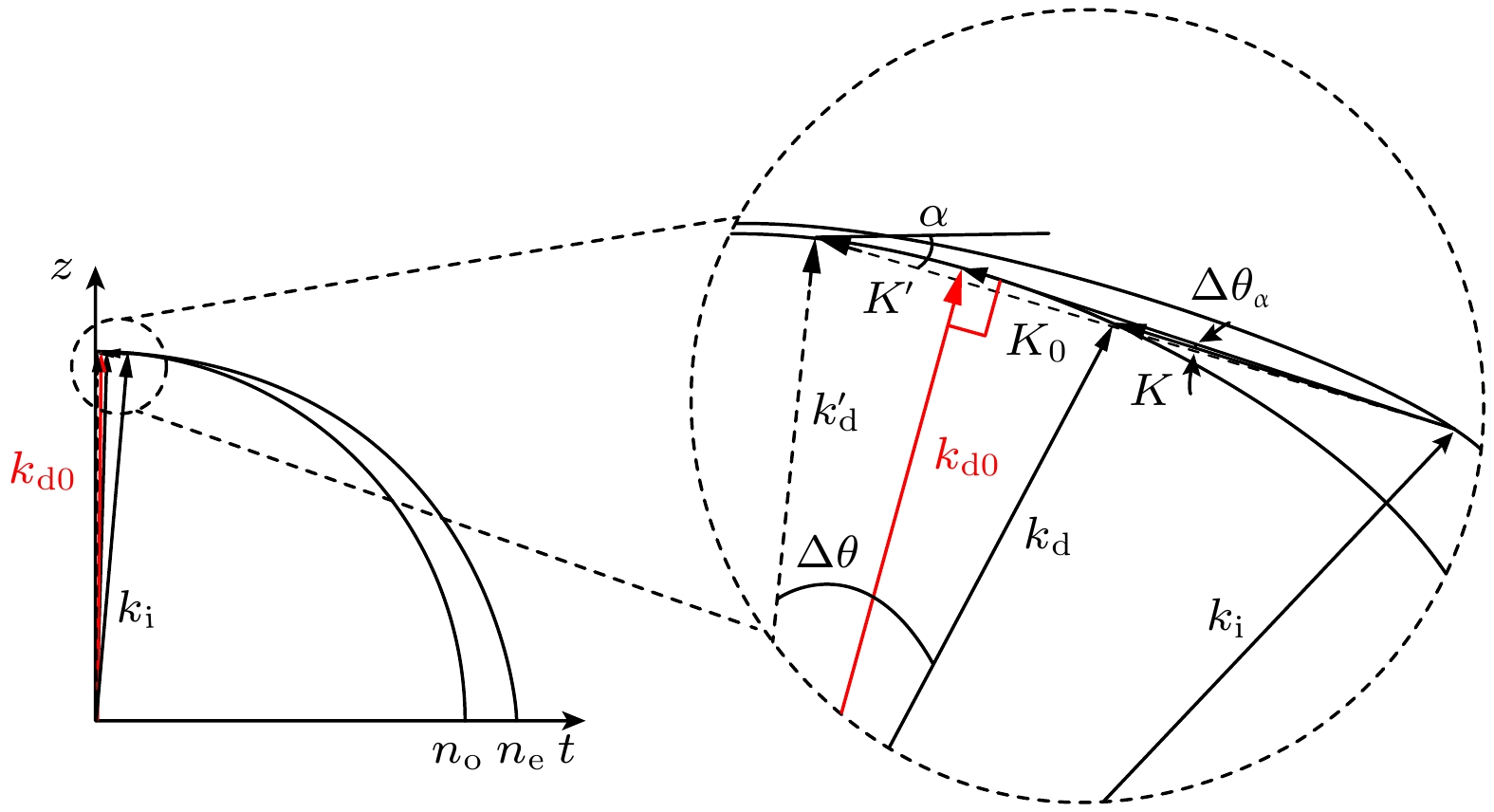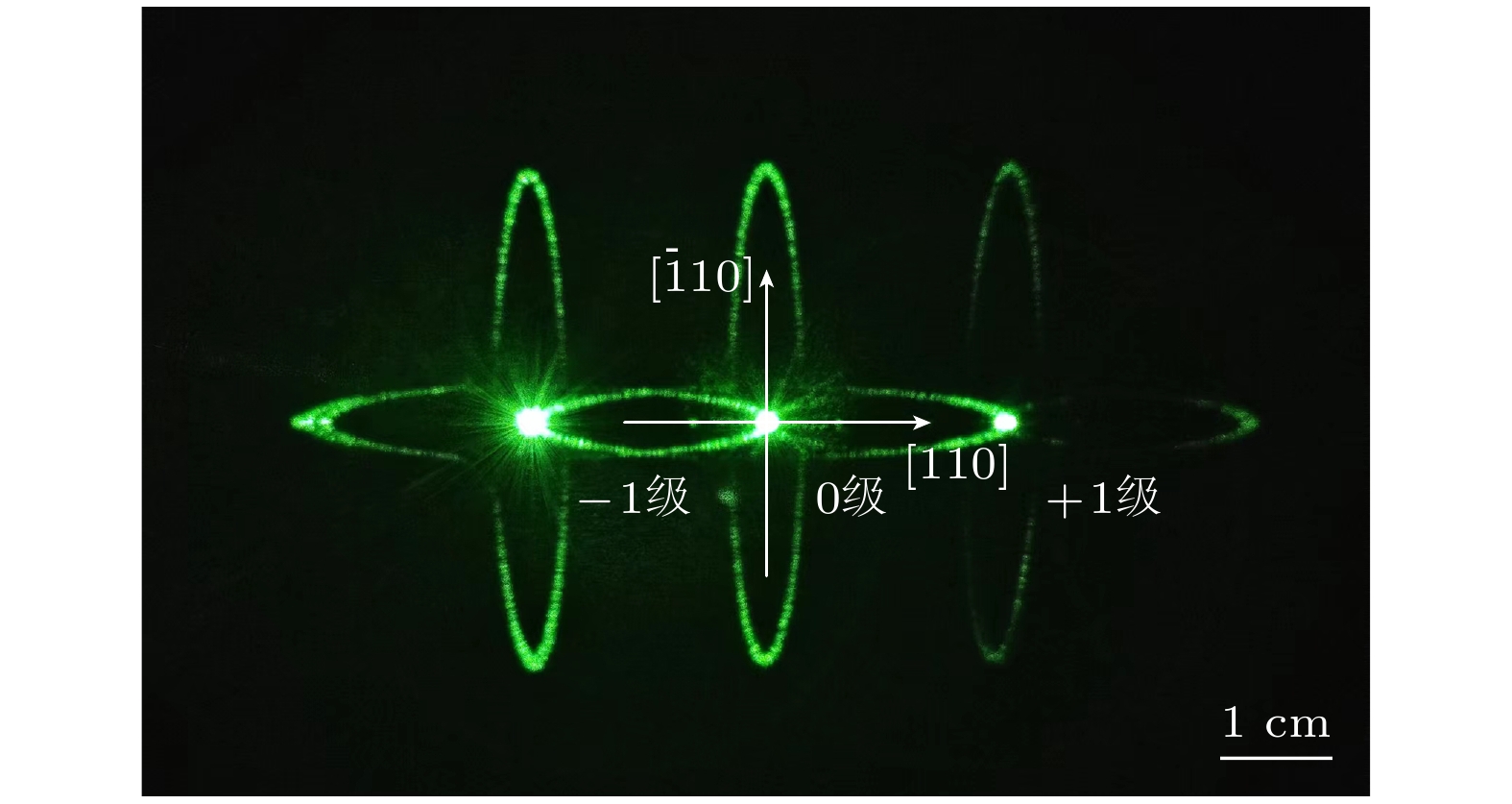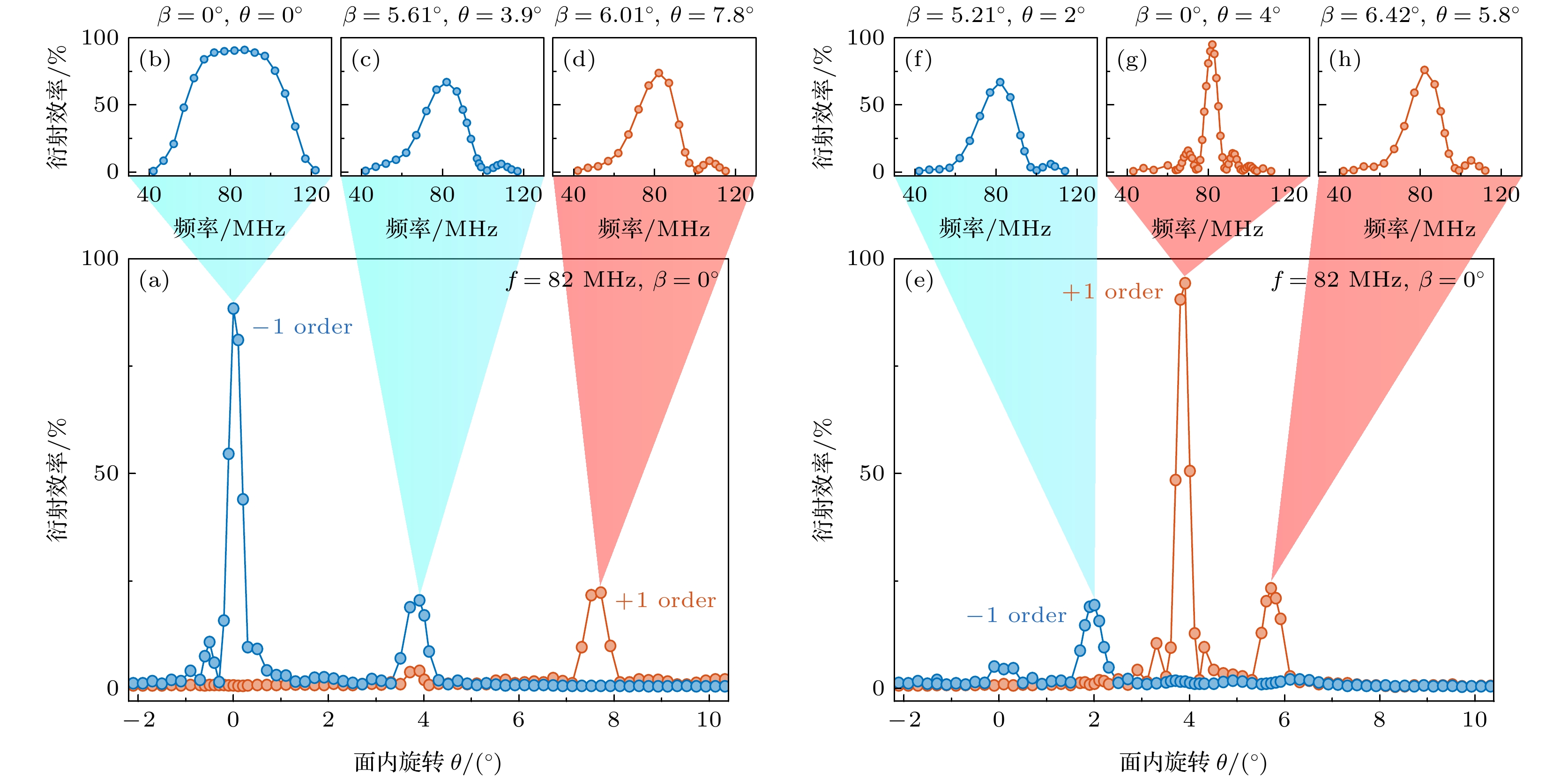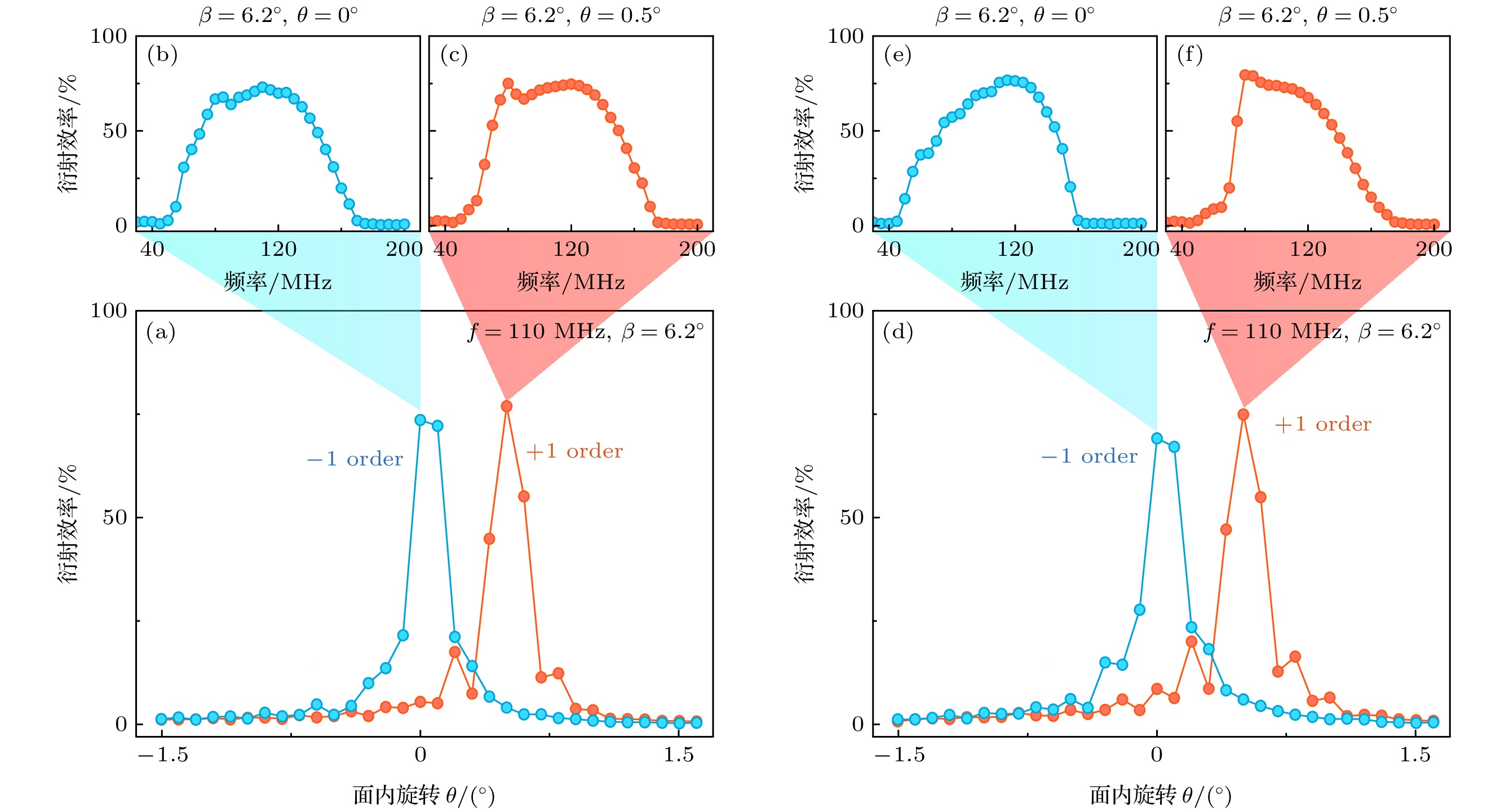-
中性原子阵列因具备单原子的精确操控能力以及强相互作用的可调性, 已成为量子计算和量子信息处理中最具潜力的物理平台之一. 声光偏转器是构建和控制中性原子阵列的关键器件, 可实现对原子的快速、高精度捕获与排列. 然而, TeO2反常布拉格型声光偏转器在实际应用中仍存在宽带衍射条件不明确、偏振敏感性与效率低等问题, 制约了其在多自由度操控中的性能发挥. 本文通过与声光调制器对比, 系统地分析了声光偏转器的工作机理, 提出了一种可快速确定宽带衍射中心频率与衍射级次的新方法, 通过全面测量不同衍射级次及不同偏振入射下的衍射效率与带宽, 获得声光偏转器的高速、高效率、大角度偏转的衍射级次和45 MHz宽频衍射频率的特定工作条件, 研究揭示了宽带偏转性能对超声波模式的依赖机制, 明确了调试过程中的关键技术参数, 为中性原子阵列的快速构建与动态可编程调控提供了重要技术支撑.
Neutral atom arrays have emerged as one of the most promising physical platforms for quantum computing and quantum information processing due to their precise single-atom control and tunable strong interactions. The acousto-optic deflector (AOD) is a key device for constructing and manipulating neutral atom arrays, enabling rapid and high-precision atom trapping and arrangement. However, TeO2-based anomalous Bragg AODs still face challenges in practical applications, such as unclear broadband diffraction conditions, polarization sensitivity, and low efficiency, which limit their performance in multi-degree-of-freedom control. This study investigates the acousto-optic effects in AOD and acousto-optic modulator (AOM), and reveals their differences in diffraction efficiency, polarization characteristics, and applications. By adjusting the azimuthal angle of the AOD, we measure the efficiency and RF bandwidth of the ±1st-order diffracted beams under horizontal and vertical polarization incident light, and propose an experimental method to determine the broadband diffraction center frequency and diffraction order. Additionally, we systematically characterize the operational parameters of AOM, clarifying their performance mechanisms and application-specific differences compared with those of AOD. The main conclusions are as follows: 1) The beam deflection performance of an AOD is closely related to the ultrasonic mode or acoustic velocity: a lower sound velocity results in a larger deflection angles. For TeO2 crystals, when a shear wave propagates along the [110] axis (sound velocity: 0.617 km/s), the diffraction angle reaches 0.842 mrad/MHz (laser wavelength: 532 nm). In contrast, when TeO2 is used in AOM with a longitudinal wave along the [001] axis (sound velocity: 4.26 km/s), the diffraction angle decreases to 0.133 mrad/MHz under the same wavelength. 2) To achieve high diffraction efficiency and a broad operational frequency range, the AOD must satisfy the phase-matching condition for anomalous Bragg diffraction. Taking the AOD (model: AA DTSX-250) for example, it operates in a unidirectional incident mode: when horizontally polarized light (extro-ordinary light) is incident, only the –1st-order diffracted beam satisfies the anomalous Bragg condition. The beam undergoes polarization conversion to vertically polarized light (ordinary light), enabling high-efficiency broadband deflection (center frequency: 82 MHz, bandwidth: 45 MHz). To support future two-dimensional deflection implementations, the input and output surfaces of the TeO2 crystal are fabricated with slight bevel angles, ensuring collinearity between the –1st-order diffracted beam and the incident beam at the center frequency. In other cases—(i) +1st-order diffraction of horizontally polarized light and (ii) ±1st-order diffraction of vertically polarized light—the anomalous Bragg condition is not met. These beams retain their original polarization and allow only narrowband deflection. These results demonstrate that AODs, leveraging anomalous acousto-optic effects, can achieve high diffraction efficiency, wide frequency tuning ranges, and large deflection angles, making them suitable for high-speed, high-precision beam steering applications. In contrast, AOMs utilize normal acousto-optic effects to perform rapid modulation of beam intensity, frequency, and phase, and are widely used in laser communication and optical fiber transmission. This study provides a detailed technical reference for understanding the operational principles of AODs and their applications in programmable neutral atom arrays. -
Keywords:
- acousto-optic deflectors /
- acousto-optic modulators /
- TeO2 crystals /
- anomalous Bragg diffraction /
- broadband diffraction
[1] Henriet L, Beguin L, Signoles A, Lahaye T, Browaeys A, Reymond G, Jurczak C 2020 Quantum 4 327
 Google Scholar
Google Scholar
[2] Barredo D, Léséleuc S, Lienhard V, Lahaye T, Browaeys A 2016 Science 354 1021
 Google Scholar
Google Scholar
[3] Endres M, Bernien H, Keesling A, Levine H, Anschuetz E, Krajenbrink A, Senko C, Vuletic V, Greiner M, Lukin M D 2016 Science 354 1024
 Google Scholar
Google Scholar
[4] Antonov S N, Kotelnikov V 2019 PAIJ 3 235
 Google Scholar
Google Scholar
[5] Wang L W, Wen K, Liu F D, Li Y D, Wang P J, Huang L H, Chen L C, Han W, Meng Z M, Zhang J 2022 Chin. Phys. B 31 103401
 Google Scholar
Google Scholar
[6] Barredo D, Lienhard V, Léséleuc S, Lahaya T, Browaeys A 2018 Nature 561 79
 Google Scholar
Google Scholar
[7] Bluvstein D, Levine H, Semeghini G, Wang T T, Ebadi S, Kalinowski M, Keesling A, Maskara N, Phchler H, Greiner M, Vuletić V, Lukin M D 2022 Nature 604 451
 Google Scholar
Google Scholar
[8] Semeghini G, Levine H, Keesling A, Ebadi S, Wang T T, Bluvstein D, Verresen R, Pichler H, Kalinowski M, Samajdar R, Omran A, Sachdev S, Vishwanath A, Greiner M, Vuletić V, Lukin M D 2021 Science 374 1242
 Google Scholar
Google Scholar
[9] Jiang R H, Zhou Z Q, Lü X H, Zeng S Q 2012 Rev. Sci. Instrum. 83 043709
 Google Scholar
Google Scholar
[10] Lyer V, Losavio B, Saggau P 2003 J Biomed. Opt. 8 460
 Google Scholar
Google Scholar
[11] 徐海全, 蒋跃 2005 空军雷达学院学报 19 17
Xu H Q, Jiang Y 2005 J. Air Force Radar Academy 19 17
[12] 蒋红艳, 何宁, 陈明 2008 光学技术 34 299
Jiang H Y, He N, Chen M 2008 Opt. Tech. 34 299
[13] Nikulin V, Khandekar R, Sofka J 2008 Opt. Eng. 47 064301
 Google Scholar
Google Scholar
[14] Yan J W, Yu X D, Han Z V, Li T C, Zhang J 2023 Photonics Res. 11 600
 Google Scholar
Google Scholar
[15] Meng Z M, Wang L W, Han W, Liu F D, Wen K, Gao C, Wang P J, Chin C, Zhang J 2023 Nature 615 231
 Google Scholar
Google Scholar
[16] Wu Y Q, Shankar P M, Lewin P A, Koller D P 1994 IEEE Trans. Ultrason. Ferroelectr. Freq. Control 41 166
 Google Scholar
Google Scholar
[17] 阮立锋, 唐志列, 刘雪凌 2013 光学学报 33 03070016
Ruan L F, Tang Z L, Liu X L 2013 Acta Opt. Sin. 33 03070016
[18] Das P, 陈焕林 1987 压电与声光 3 42
Das P, Chen H L 1987 Piezoelectrics & Acoustooptics 3 42
[19] 李强, 郑义军, 王智勇, 李港, 左铁钏 2003 中国激光 30 795
Li Q, Zheng Y J, Wang Z Y, Li G, Zuo T C 2003 Chin. J. Lasers 30 795
[20] Zhang Z W, Wen Z Y, Shang Z G, Li D L, Hu J 2012 J. Semicond. 33 094009
 Google Scholar
Google Scholar
[21] Schrödel Y, Hartmann C, Zheng J A, Lang T, Steudel M, Rutsch M, Salman S H, Kellert M, Pergament M, Hahn-Jose T, Suppelt S, Dörsam J H, Harth A, Leemans W P, Kärtner F X, Hartl I, Kupnik M, Heyl C M 2024 Nat. Photonics 18 54
 Google Scholar
Google Scholar
[22] Baryshev V N, Epikhin V M 2010 Quantum Electron. 40 431
 Google Scholar
Google Scholar
[23] Wen K, Meng Z M, Wang L W, Chen L C, Huang L H, Zhou L H, Cui X L, Zhang J 2020 Sci. Rep. 10 5870
 Google Scholar
Google Scholar
[24] Chen L C, Wang P J, Meng Z M, Huang L H, Cai H, Wang D W, Zhu S Y, Zhang J 2018 Phys. Rev. Lett. 120 193601
 Google Scholar
Google Scholar
[25] Wang P J, Chen L C, Mi C D, Meng Z M, Huang L H, Nawaz K S, Cai H, Wang D W, Zhu S Y, Zhang J 2020 npj Quantum Inf. 6 18
 Google Scholar
Google Scholar
[26] Xu J, Stroud R 1992 Acousto-Optic Devices: Principles, Design, and Applications (Hoboken: Wiley-Interscience
[27] 徐介平 1978 27 421
 Google Scholar
Google Scholar
Xu J P 1978 Acta Phys. Sin. 27 421
 Google Scholar
Google Scholar
[28] 李德荣, 吕晓华, 吴萍, 骆清铭, 陈伟, 曾绍群 2006 55 4729
 Google Scholar
Google Scholar
Li D R, Lü X H, Wu P, Luo Q M, Chen W, Zeng S Q 2006 Acta Phys. Sin. 55 4729
 Google Scholar
Google Scholar
-
图 1 反常声光相互作用几何关系. t轴为TeO2的[110]轴(超声切变波方向), z轴为TeO2的[001]轴(入射光方向). no和ne分别为o光、e光的折射率球面. kd0为宽带衍射中心频率的衍射矢量, kd~$ {\boldsymbol{k}}_{\mathrm{d}}' $为工作频率范围的两个极大点衍射矢量, $ \Delta \theta $为工作频率范围内的两个极大点衍射偏转角. α为超声切变波矢量与t轴的夹角
Fig. 1. Geometric relationship of anomalous acousto-optic interaction. The t-axis represents the [110] axis of TeO2 (the direction of the ultrasonic shear wave), and the z-axis represents the [001] axis of TeO2 (the direction of the incident beam). no and ne are the refractive index spheres of the ordinary light and the extraordinary light respectively. kd0 is the diffraction vector of the central frequency of the broadband diffraction, kd~$ {\boldsymbol{k}}_{\mathrm{d}}' $ are the diffraction vectors of the two maximum points within the operating frequency range, and $ \Delta \theta $ is the diffraction deflection angle of the two maximum points within the operating frequency range. α is the angle between the ultrasonic shear wave vector and the t axis.
图 2 声光偏转器舍弗-伯拉曼图(声光介质为TeO2), 实验条件对应图4(b)的中心频率处. 左侧点为–1级衍射光, 中间点为0级光, 右侧点为+1级衍射光
Fig. 2. Schaefer-Bergmann diagram of the acousto-optic deflector (with TeO2 as the acousto-optic medium), the experimental conditions correspond to the central frequency in Fig. 4(b). The point on the left is the –1st order diffracted light, the point in the middle is the 0th order light, and the point on the right is the +1st order diffraction light.
图 3 声光偏转器(AOD)、声光调制器(AOM)的0级光和±1级衍射光 (a)无射频信号输入时, 入射光注入声光偏转器, 0级光会偏折, 未与注入光重合; 射频信号输入时(频率为满足宽频偏转时的中心频率), ±1级衍射光在0级光的左右两侧, –1级衍射光与入射光路重合; (b)无射频信号输入时, 入射光注入声光调制器, 0级光未发生偏折, 与入射光路重合; 射频信号输入时, ±1级衍射光在0级光的左右两侧; (c)面内和面外的旋转角度
Fig. 3. The 0th order light and ±1st order diffracted light of the acousto-optic deflector (AOD) and the acousto-optic modulator (AOM): (a) When there is no radio frequency (RF) signal input, the incident beam is injected into the AOD, and the 0th order light will be deflected and does not overlap with the incident beam. When the RF signal is input (at the central frequency), the ±1st order diffracted light appears on the left and right sides of the 0 th order light, and the –1st order diffracted light overlap with the incident light path; (b) when there is no RF signal input, the incident beam is injected into the AOM, and the 0th order light is not deflected and overlaps with the incident light path. When the RF signal is input, the ±1st order diffracted light appears on the left and right sides of the 0th order light; (c) the in-plane and out-of-plane rotation angles.
图 4 声光偏转器的衍射效率与水平、垂直偏振光及入射角度的关系, 蓝色线、红色线分别为–1, +1级衍射光效率 (a)入射光为水平偏振, –1级有两次衍射极值, 第一次衍射极值条件(b)满足反常声光互作用, 衍射光为垂直偏振, 带宽为45 MHz, 满足高效率、大角度偏转的要求; 其余情况((c), (d))的衍射带宽仅为13 MHz和15 MHz; (e)入射光为垂直偏振, –1级(f)、+1级((g), (h))衍射光不满足反常声光互作用条件, 高效率衍射带宽分别为15 MHz, 4 MHz, 11 MHz
Fig. 4. Relationship between the diffraction efficiency of the acousto-optic deflector and the incident angles of horizontal and vertical polarization light. The blue line and the red line represent the diffraction efficiencies of the –1st and +1st order diffracted light respectively: (a) When the incident light is horizontal polarization, the –1st order has two diffraction extreme values. The condition for the first diffraction extreme value (b) satisfies the anomalous acousto-optic interaction. The diffracted light is vertical polarization, with a bandwidth of 45 MHz, meeting the requirements of high efficiency and large-angle deflection. In the remaining cases ((c), (d)), the diffraction bandwidths are limited to only 13 MHz and 15 MHz, respectively; (e) when the incident beam is vertical polarization, the –1st order (f) and +1st order ((g), (h)) diffracted beam do not satisfy the conditions of the anomalous acousto-optic interaction. Their high-efficiency diffraction bandwidths are measured to be 15 MHz, 4 MHz, and 11 MHz respectively.
图 5 声光调制器的衍射效率与水平、垂直偏振光及入射角度的关系, 青色线、红色线分别为–1, +1级衍射光效率 (a)—(c)入射光为垂直偏振; (d)—(f)入射光为水平偏振
Fig. 5. Relationship between the diffraction efficiency of the AOM and the incident angles of horizontal and vertical polarization beam. The cyan line and the red line represent the diffraction efficiencies of the –1st and +1st order diffraction light respectively: (a)–(c) The incident beam is vertical polarization; (d)–(f) the incident beam is horizontal polarization.
-
[1] Henriet L, Beguin L, Signoles A, Lahaye T, Browaeys A, Reymond G, Jurczak C 2020 Quantum 4 327
 Google Scholar
Google Scholar
[2] Barredo D, Léséleuc S, Lienhard V, Lahaye T, Browaeys A 2016 Science 354 1021
 Google Scholar
Google Scholar
[3] Endres M, Bernien H, Keesling A, Levine H, Anschuetz E, Krajenbrink A, Senko C, Vuletic V, Greiner M, Lukin M D 2016 Science 354 1024
 Google Scholar
Google Scholar
[4] Antonov S N, Kotelnikov V 2019 PAIJ 3 235
 Google Scholar
Google Scholar
[5] Wang L W, Wen K, Liu F D, Li Y D, Wang P J, Huang L H, Chen L C, Han W, Meng Z M, Zhang J 2022 Chin. Phys. B 31 103401
 Google Scholar
Google Scholar
[6] Barredo D, Lienhard V, Léséleuc S, Lahaya T, Browaeys A 2018 Nature 561 79
 Google Scholar
Google Scholar
[7] Bluvstein D, Levine H, Semeghini G, Wang T T, Ebadi S, Kalinowski M, Keesling A, Maskara N, Phchler H, Greiner M, Vuletić V, Lukin M D 2022 Nature 604 451
 Google Scholar
Google Scholar
[8] Semeghini G, Levine H, Keesling A, Ebadi S, Wang T T, Bluvstein D, Verresen R, Pichler H, Kalinowski M, Samajdar R, Omran A, Sachdev S, Vishwanath A, Greiner M, Vuletić V, Lukin M D 2021 Science 374 1242
 Google Scholar
Google Scholar
[9] Jiang R H, Zhou Z Q, Lü X H, Zeng S Q 2012 Rev. Sci. Instrum. 83 043709
 Google Scholar
Google Scholar
[10] Lyer V, Losavio B, Saggau P 2003 J Biomed. Opt. 8 460
 Google Scholar
Google Scholar
[11] 徐海全, 蒋跃 2005 空军雷达学院学报 19 17
Xu H Q, Jiang Y 2005 J. Air Force Radar Academy 19 17
[12] 蒋红艳, 何宁, 陈明 2008 光学技术 34 299
Jiang H Y, He N, Chen M 2008 Opt. Tech. 34 299
[13] Nikulin V, Khandekar R, Sofka J 2008 Opt. Eng. 47 064301
 Google Scholar
Google Scholar
[14] Yan J W, Yu X D, Han Z V, Li T C, Zhang J 2023 Photonics Res. 11 600
 Google Scholar
Google Scholar
[15] Meng Z M, Wang L W, Han W, Liu F D, Wen K, Gao C, Wang P J, Chin C, Zhang J 2023 Nature 615 231
 Google Scholar
Google Scholar
[16] Wu Y Q, Shankar P M, Lewin P A, Koller D P 1994 IEEE Trans. Ultrason. Ferroelectr. Freq. Control 41 166
 Google Scholar
Google Scholar
[17] 阮立锋, 唐志列, 刘雪凌 2013 光学学报 33 03070016
Ruan L F, Tang Z L, Liu X L 2013 Acta Opt. Sin. 33 03070016
[18] Das P, 陈焕林 1987 压电与声光 3 42
Das P, Chen H L 1987 Piezoelectrics & Acoustooptics 3 42
[19] 李强, 郑义军, 王智勇, 李港, 左铁钏 2003 中国激光 30 795
Li Q, Zheng Y J, Wang Z Y, Li G, Zuo T C 2003 Chin. J. Lasers 30 795
[20] Zhang Z W, Wen Z Y, Shang Z G, Li D L, Hu J 2012 J. Semicond. 33 094009
 Google Scholar
Google Scholar
[21] Schrödel Y, Hartmann C, Zheng J A, Lang T, Steudel M, Rutsch M, Salman S H, Kellert M, Pergament M, Hahn-Jose T, Suppelt S, Dörsam J H, Harth A, Leemans W P, Kärtner F X, Hartl I, Kupnik M, Heyl C M 2024 Nat. Photonics 18 54
 Google Scholar
Google Scholar
[22] Baryshev V N, Epikhin V M 2010 Quantum Electron. 40 431
 Google Scholar
Google Scholar
[23] Wen K, Meng Z M, Wang L W, Chen L C, Huang L H, Zhou L H, Cui X L, Zhang J 2020 Sci. Rep. 10 5870
 Google Scholar
Google Scholar
[24] Chen L C, Wang P J, Meng Z M, Huang L H, Cai H, Wang D W, Zhu S Y, Zhang J 2018 Phys. Rev. Lett. 120 193601
 Google Scholar
Google Scholar
[25] Wang P J, Chen L C, Mi C D, Meng Z M, Huang L H, Nawaz K S, Cai H, Wang D W, Zhu S Y, Zhang J 2020 npj Quantum Inf. 6 18
 Google Scholar
Google Scholar
[26] Xu J, Stroud R 1992 Acousto-Optic Devices: Principles, Design, and Applications (Hoboken: Wiley-Interscience
[27] 徐介平 1978 27 421
 Google Scholar
Google Scholar
Xu J P 1978 Acta Phys. Sin. 27 421
 Google Scholar
Google Scholar
[28] 李德荣, 吕晓华, 吴萍, 骆清铭, 陈伟, 曾绍群 2006 55 4729
 Google Scholar
Google Scholar
Li D R, Lü X H, Wu P, Luo Q M, Chen W, Zeng S Q 2006 Acta Phys. Sin. 55 4729
 Google Scholar
Google Scholar
计量
- 文章访问数: 408
- PDF下载量: 13
- 被引次数: 0














 下载:
下载:




